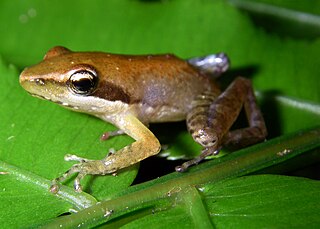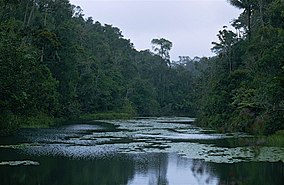Andasibe-Mantadia National Park is a 155 square kilometre protected area, located about 150 km east of Antananarivo, consisting principally of primary growth forest in Alaotra-Mangoro Region in eastern Madagascar. The park's elevation ranges from 800 to 1260 meters, with a humid climate. Average annual precipitation is 1700 mm, with rainfall on 210 days of each year. This rainforest is habitat to a vast species biodiversity, including many endemic rare species and endangered species, including 11 lemur species. The park's two component parts are Mantadia National Park and Analamazoatra Reserve, which is best known for its population of Madagascar's largest lemur, the indri.

Moramanga is a city in Madagascar. It is located in the region Alaotra-Mangoro and the Moramanga District. It has a population of 57084 inhabitants (2018).
Leptolaena abrahamii is a species of flowering plant in the family Sarcolaenaceae. It is found only in Madagascar. Its natural habitat is mid-elevation humid tropical forests. It is threatened by habitat loss.

Blommersia blommersae is a species of frog in the family Mantellidae. It is endemic to east-central Madagascar. Both the generic and specific names honour Rose Marie Antoinette Blommers-Schlösser, a Dutch herpetologist and entomologist who collected the type series. Common name Moramanga Madagascar frog has been proposed for it.

Alaotra-Mangoro is a region in eastern Madagascar. It borders Sofia Region in north, Analanjirofo in northeast, Atsinanana in east, Vakinankaratra in southwest, Analamanga in west and Betsiboka in northwest. The capital of the region is Ambatondrazaka, and the population was 1,255,514 in 2018. The area of the region is 31,948 km2 (12,335 sq mi).

Andasibe is a rural municipality in Madagascar. It belongs to the district of Moramanga, which is a part of Alaotra-Mangoro Region. The population of the commune was estimated to be approximately 13493 in 2006.
Analamerana Special Reserve is a 347 square kilometres (134 sq mi) wildlife reserve in the north of Madagascar. The reserve was created in 1956 to protect its endemic plants and animals, such as the critically endangered Perrier's sifaka, which is considered to be one of the most endangered primates in the world.
Ambohijanahary Special Reserve is a wildlife reserve in the regions of Menabe and Melaky in Madagascar. The reserve was created in 1958 to protect the sclerophyllous forest between Tsiroanomandidy and Maintirano, as well as protecting the many endemic species of plants and animals.
Bora Special Reserve is a wildlife reserve in the Sofia Region of Madagascar, between the villages of Antsohihy and Bealalana. Bora is in a transition zone between eastern humid forests and western dry forests and the reserve and has many endemic species including six lemur species, twenty birds and over 150 species of endemic plants.
Kasijy Special Reserve is a 19,800 hectares wildlife reserve in the Betsiboka region of Madagascar. Nearly half of the species of plants and animals recorded within the reserve are endemic to Madagascar and BirdLife International have listed the reserve as an Important Bird Area.)
Mangerivola Special Reserve is a wildlife reserve in the east of Madagascar. It was established in 1958 and is a hotspot for bird-watchers due to the one hundred species found there, including 63 endemics and many local endemics. There are also seven species of lemur and rare chameleons such as the Lance-nosed chameleon which is registered as endangered on the IUCN Red List of Threatened Species.

Moramanga District is a district in the Alaotra-Mangoro region in Madagascar. Its capital is Moramanga.

Route nationale 2 (RN2) is a primary highway in Madagascar. The route runs from the capital city of Antananarivo to Toamasina, a city on the eastern coast of the Madagascar.

Calumma brevicorne, the short-horned chameleon, is a species of chameleon endemic to Madagascar.
Analamazaotra Forest Station is a community-managed protected area in Analamazaotra National Park, and adjacent to Andasibe-Mantadia National Park, in the Alaotra-Mangoro region of east-central Madagascar. It consists of 710 hectares of rain forest and restored habitat. It is managed through a contract between the local community-run organization Mitsinjo and the Ministère des Eaux et Forets. Much of the forest station is being reforested with native vegetation through a habitat restoration project. Part of the David Attenborough-hosted 2011 BBC Madagascar documentary was filmed at Analamazaotra Forest Station, including a scene where lowland streaked tenrecs cross a small stream.

Madagascar Exotic is a small privately run reserve at Marozevo, on National Road N2, 75 km (47 mi) east of Antananarivo, between the towns of Manjakandriana and Moramanga. It is a popular tourist stop between Antananarivo and Madagascar's Andasibe-Mantadia National Park.

The Sahatandra is a small river that flows thru Andasibe, Moramanga, Alaotra-Mangoro Region, Madagascar and the Andasibe-Mantadia National Park.
Andasibe is a commune in Mananara Nord, Analanjirofo, Madagascar.
Mitsinjo is a town and commune in western Madagascar.










